Economic activity of the population - 1 quarter
08.05.2009
Code: q-3133-09
In the EU the Czech Republic belongs to the countries with the highest average number of hours worked in main job. According to Eurostat, average hours actually worked in main job per week in the Czech Republic were the fifth highest, after Germany, Austria, the Netherlands and Greece. However, the trend of hours worked in Q1 2009 was affected by deteriorating global economic and financial conditions.
The total of hours worked depends primarily on the trend of total employment in the national economy – of a priority impact in the Czech Republic is the number of persons in full-time main job. Different impacts of economic difficulties on individual sectors of the economy, generally quantifiable by the trend of average hours worked in the reference week, are another factor. In comparison to the other European economies, the impact of other factors such as the number of second jobs and the corresponding hours worked is smaller.
After a rapid growth of employment in 2008 the total number of persons in main job in the civil sector of the economy (excl. the armed forces) fell by 10.7 thousand in Q1 2009 and reached 4 931.7 thousand. This fall was mainly caused by the negative trend of number of persons in the status of employees, whereas the self-employed including family workers continued growing compared with Q1 2008. The impacts of economic difficulties are unevenly distributed, which is apparent from the fact that, while the number of persons in employment in the tertiary sector (services) grew by 51 thousand, persons working in the secondary sector (industry and construction) dropped by the nearly same number and employment in the primary sector (agriculture, forestry and fishing) dropped by over 11 thousand.
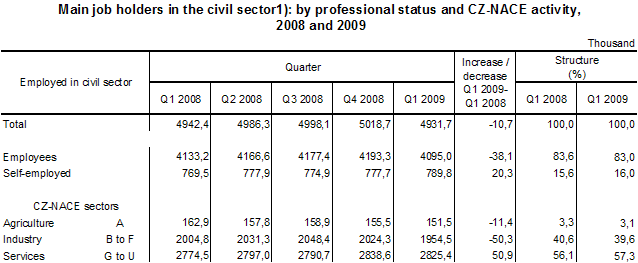
1) The civil sector does not include members of the armed forces, on a voluntary or compulsory basis, who cannot take a civil job on their own. They are especially soldiers and pilots and other persons undergoing the daily training. This main class does not include persons in civil jobs, though they may be involved in the defence issues, also excluded are policepersons, customs officers and members of other armed forces.
Another factor affecting hours worked is the proportion between persons in full-time main job and part-time main job. In Q1 2009 the number of persons in the civil sector working part-time exceeded 264 thousand, which was by 34 thousand more compared with Q1 2002 (the first reference period for which comparable data in the LFSS database are available) and by 24 thousand more compared with Q1 2008.
The percentage of part-time jobs thus reached 5.4% of the total number of main jobs in the civil sector in Q1 2009, as against 4.9% in Q1 2008. Though women mostly fill part-time jobs, in Q1 2009 the annual increase of men in part-time job was higher in comparison with the increase of women working part time.
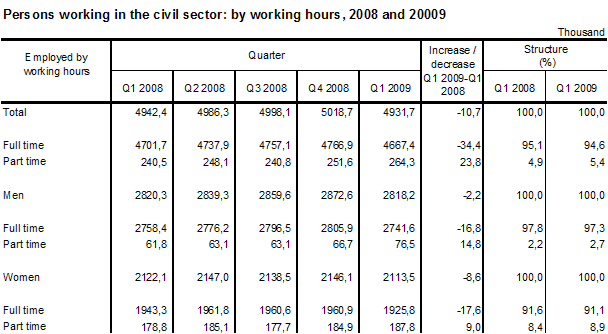
However, employment is affected by the present economic situation not only through changes in total employment and increasing number of part-time main jobs. A more complex impact on the amount of hours worked can be demonstrated by the trend of the respondents’ average weekly working hours in main job. The consideration of the trend can be based either on the indicator of hours usually worked, which is affected by legislative conditions in effect for individual types of occupations and sectors, or on the indicator of average hours actually worked in the reference period. While the average number of hours usually worked did not change much in the surveyed period (annual decrease by 0.2 hours to 41.5 hours per week), hours actually worked did change; they fell by 1.1 (nearly -3%) per week compared with Q1 2008.
Decreases of average hours actually worked in main job per week were recorded for both employees and the self-employed. Larger differences were found between CZ-NACE activities than between individual categories of professional status. According to the new CZ-NACE Rev. 2 classification, average hours actually worked per week in main job decreased by 0.7 (-2.0%ˇ) in the sector of services, and by as much as 1.7 (-4.4%) in the sector of industry and construction and 1.9 (-4.7%) in the primary sector. Average hours actually worked per week in the secondary and tertiary sectors decreased in Q1 2009 compared with Q3 2008 when holidays were made.
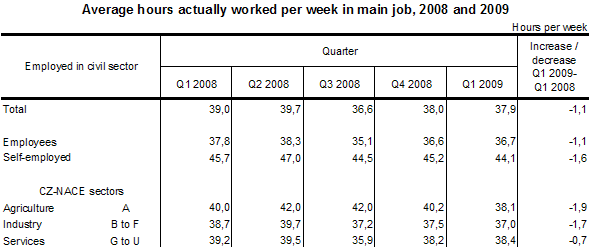
It should be noted that the number of working days was the same in both quarters of 2008 and 2009 as determined by Eurostat definition. The trend of average hours worked per week may be considered using an indicator which, for the purpose of temporal comparisons, does not include persons working in the reference period fewer hours than usually hours due to public holidays (not due to sickness or leave). Applying this criterion, the difference in average hours actually worked per person employed is even higher than when applying the standard determination of the number of persons employed in the civil sector. Average hours per week worked by respondents determined in this way in main job fell by 1.6 (-4.0%). The decreases of 2.2 hours (-5.6%) in the secondary sector and 2.2 hours (-5.4%) in the primary sector were marked; the decrease of 1.1 hours (-2.8%) among respondents employed in services was smaller.
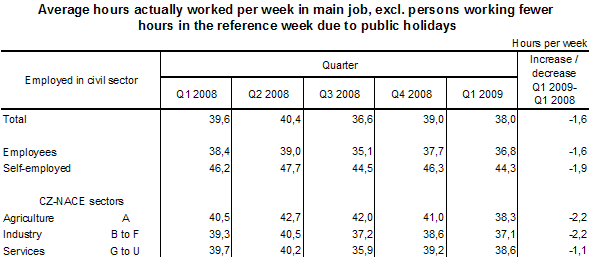
This criterion of determining the number of persons for which hours actually worked per week are calculated may also be used for the consideration of annual changes in the structure of persons employed by number of hours actually worked. The number of persons who did not work an hour in the reference week grew considerably and those who worked fewer hours than the average increased noticeably. The number of persons working 40.0–44.9 hours per week is an exception; however, it by far did not compensated for the high increase of persons working zero or fewer hours than the average and was even smaller than the decrease of persons working more hours that the average. The trend of the structure of all persons employed in the civil sector by hours worked is primarily based on changes in the structure in the category of employees. The table below gives a rough picture of the magnitude of increase of persons who worked in the reference week fewer hours than stipulated in their employment contracts.
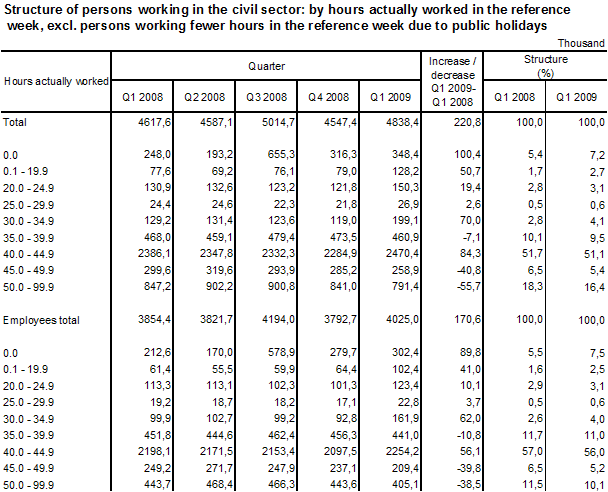
Second jobs do not play an important role in the Czech Republic compared to some of the other EU countries. Despite their annual rise by 9.6 thousand (+11.1%) to 93.7 thousand, the impact of this increase was largely cushioned by a decrease in average hours actually worked per week by 0.8 (-6.1%). The total of hours actually worked in second jobs thus grew by 4.7% compared with Q1 2008. As the percentage of persons in main job, particularly those working full time, is very high, the share of hours actually worked in second jobs was as low as 0.6% of hours worked by Czech residents in all forms of jobs.
* * * * *
The decisive impact on annual changes in hours worked in main job was a decrease of hours actually worked in full-time main job and the fall in total employment was a secondary impact. The total of hours actually worked in main job, relating in accordance with EU methodology for the sample survey to employed persons living in dwellings in the Czech Republic, decreased by 3.1% compared with Q1 2008.
The total of hours worked by employees fell significantly (-3.7%), while that worked by the self-employed dropped by less than one per cent. A positive effect of the total increase of the number of the self-employed showed itself in the business sphere, although average hours actually worked in main job per week in the same category dropped too.
The very high annual decrease of 11.4% in hours worked in the primary sector was, besides economic difficulties, affected by the trend of last winter. The unfavourable economic situation had a significant impact on many CZ-NACE activities in the secondary sector – the total of hours worked in industry and construction fell by 6.7% compared with Q1 2008. The sample survey does not cover employed persons not living in dwellings. However, a large part of foreign nationals live beyond the permanently occupied dwelling stock and the real annual fall in hours worked in industry and construction is probably even higher. On the other hand, the total of hours worked in the tertiary sector remained at the level of Q1 2008; the decrease of average hours worked was offset by employment growth in the sector.
Contact: Information Services Unit - Headquarters, tel.: +420 274 056 789, email: infoservis@czso.cz










